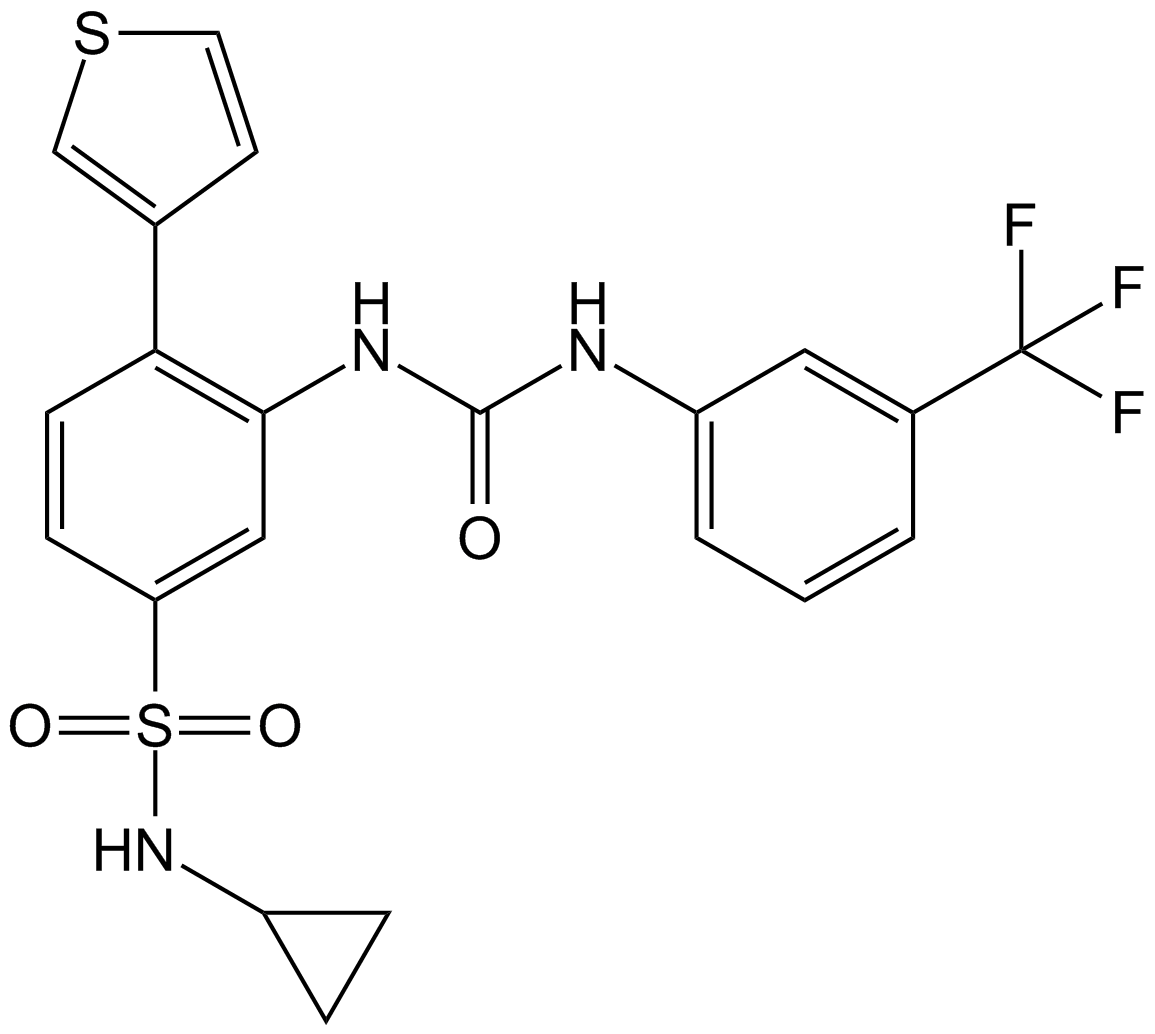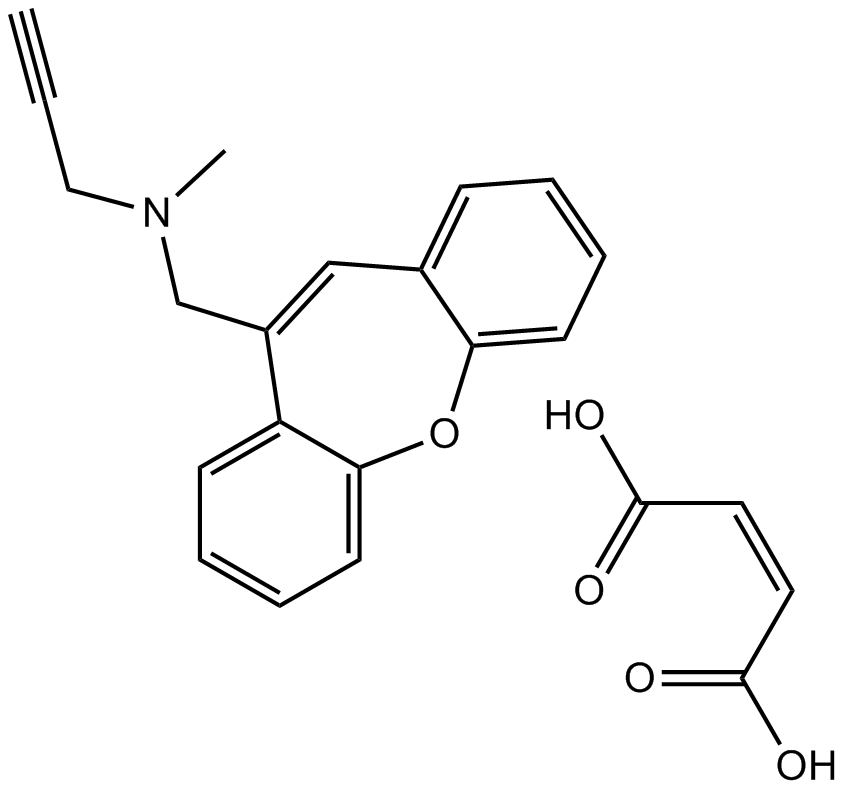CPI-613
CPI-613 is a first-in-class anti-cancer agent [1].
CPI-613 is developed to target the pyruvate dehydrogenase complex which is a key mitochondrial enzyme of anaerobic glycolysis in tumor cells. The pyruvate dehydrogenase (PDH) and alpha-ketoglutarate dehydrogenase (KGDH) play critical roles in the interconversion of both pyruvate and alpha-ketoglutarate to key biosynthetic intermediates in mitochondrial carbon metabolism process. The complex of the two enzymes requires lipoate to be as a co-factor. CPI-613 is a derivative of lipoate and therefore inhibits the energy metabolism in mitochondria [1].
CPI-613 inhibited growth of various acute myeloid leukemia (AML) cell lines with IC50 values of 16.4, 13.4 and 12.2 μM in HL60, Jurkat and K562 cells, respectively. The treatment of CPI-613 induced apoptosis dose-dependently in OCI-AML3 and K562 cells. In H460 cells cultured in medium containing glutamine and pyruvate as the predominant carbon sources, treatment of CPI-613initiallyreversible ATP level reduction. When the treatment time was above 2 hours, cells became irreversibly committed to death. In the JC-1 localization assay, CPI-613 reduced mitochondrial membrane potential significantly. Besides that, when combined with doxorubicin, the treatment showed synergistic effects in Jurkat and K562 cells [1 and 2].
CPI-613 was proved to have little side-effect toxicity in expected therapeutic dose ranges and be well tolerated at very high doses (the maximum tolerated dose in mice was ca.100 mg/kg). Administration of CPI-613 at dose of 10 mg/kg resulted in significant inhibition of tumor growth in mice bearing H460 human non-small cell lung carcinoma. CPI-613 also caused robust tumor growth inhibition in mouse model of human pancreatic tumor (BxPC-3) xenografts [2].
References:
[1] Pardee T S, Levitan D, Hurd D. Altered mitochondrial metabolism as a target in acute myeloid leukemia. J ClinOncol, 2011, 29(suppl): 6590-6591.
[2] Zachar Z, Marecek J, Maturo C, et al. Non-redox-active lipoatederivates disrupt cancer cell mitochondrial metabolism and are potent anticancer agents in vivo. Journal of molecular medicine, 2011, 89(11): 1137-1148.
- 1. JUI-CHUNG CHIANG, ZENGFU SHANG, et al. "Lipoylation inhibition enhances radiation control of lung cancer by suppressing homologous recombination DNA damage repair." SCIENCE ADVANCES 12 Mar 2025 Vol 11, Issue 11
- 2. Haitao Wen, Jianwen Chen, et al. "Repression of ferroptotic cell death by mitochondrial calcium signaling." Res Sq. 2023 Jul 10;rs.3.rs-3029860. PMID: 37502961
- 3. Tianliang Li, Ligang Kong, et al. "Listeria monocytogenes upregulates mitochondrial calcium signalling to inhibit lc3-associated phagocytosis as a survival strategy." Nat Microbiol. 2021 Mar;6(3):366-379. PMID:33462436
- 4. Li A, Liu Q, et al. "Berberine Reduces Pyruvate-driven Hepatic Glucose Production by Limiting Mitochondrial Import of Pyruvate through Mitochondrial Pyruvate Carrier 1." EBioMedicine. 2018 Aug;34:243-255. PMID:30093307
| Physical Appearance | A solid |
| Storage | Store at -20°C |
| M.Wt | 388.59 |
| Cas No. | 95809-78-2 |
| Formula | C22H28O2S2 |
| Solubility | insoluble in H2O; ≥19.45 mg/mL in DMSO; ≥93.2 mg/mL in EtOH |
| Chemical Name | 6,8-bis(benzylsulfanyl)octanoic acid |
| SDF | Download SDF |
| Canonical SMILES | C1=CC=C(C=C1)CSCCC(CCCCC(=O)O)SCC2=CC=CC=C2 |
| Shipping Condition | Small Molecules with Blue Ice, Modified Nucleotides with Dry Ice. |
| General tips | We do not recommend long-term storage for the solution, please use it up soon. |
| Cell experiment [1]: | |
|
Cell lines |
NCI-H460 NSCLC human tumor cells |
|
Preparation method |
The solubility of this compound in DMSO is >19.5mg/mL. General tips for obtaining a higher concentration: Please warm the tube at 37℃ for 10 minutes and/or shake it in the ultrasonic bath for a while. Stock solution can be stored below -20℃ for several months. |
|
Reacting condition |
50-300 μM |
|
Applications |
In series of tumor cell lines, CPI-613 efficiently killed tumor cells. In H460 human lung cancer cells cultured in medium containing pyruvate and glutamine, CPI-613 significantly reduced ATP levels within less than 60 min and this reduction was initially reversible. After longer treatment times, cells become irreversibly to execute cell death. CPI-613 differentially inhibited PDH activity in normal and tumor cells. |
| Animal experiment [1]: | |
|
Animal models |
nude mouse human tumor xenograft model of a pancreatic tumor cell (BxPC-3) and a non-small cell lung tumor cell (H460) |
|
Dosage form |
25 mg/kg; once weekly; four treatments at 7-day intervals; intraperitoneal injection.10 mg/kg; once weekly, three times weekly, or five times weekly; intraperitoneal injection. |
|
Application |
In human pancreatic (BxPC-3) xenograft carrying nude mouse, CPI-613 significantly inhibited tumor growth and over 40% of treated animals survived until the experiment was terminated at over 8 months (259 days). CPI-613 (10 mg/kg) also inhibited the growth of H460 human non-small cell lung carcinoma and the maximum tolerated dose was ca.100 mg/kg. |
|
Other notes |
Please test the solubility of all compounds indoor, and the actual solubility may slightly differ with the theoretical value. This is caused by an experimental system error and it is normal. |
|
References: [1] Zachar Z, Marecek J, Maturo C, et al. Non-redox-active lipoatederivates disrupt cancer cell mitochondrial metabolism and are potent anticancer agents in vivo. Journal of molecular medicine, 2011, 89(11): 1137-1148. |
|
| Description | CPI-613 is an inhibitor of pyruvate dehydrogenase (PDH) and α-ketoglutarate dehydrogenase (α-KDH). | |||||
| Targets | PDH | |||||
| IC50 | α-KDH | |||||
Quality Control & MSDS
- View current batch:
Chemical structure

Related Biological Data

Related Biological Data












